The Samsung Galaxy Note5 and Galaxy S6 edge+ Review
by Joshua Ho on October 2, 2015 8:00 AM ESTDisplay
With the rise of smartphones and tablets, the display has become one of the most important aspects of a mobile device as it’s the primary mode of interaction. However, throughout computing the display has generally had relatively little attention. People might have talked about resolution, size, and latency, but the discourse was vague at best. In order to really understand displays, it’s important to discuss a number of factors that affect display quality and the underlying design of the display. These factors range from subpixel arrangement to TFT structure and various emitter materials. With traditional reviewing methods, it’s often difficult to say one way or another whether one display is “better” than another. While simple metrics like maximum brightness can be compared in a relative manner, it’s hard to say whether one has better colors or higher static contrast. In order to test these metrics, we turn to objective measurements from devices like X-Rite’s i1Pro2 spectrophotometer and i1Display Pro colorimeter. In order to acquire the data from these devices and present it in a usable manner, we use SpectraCal’s CalMAN 5 with a custom workflow.
Under the microscope and based upon some quick viewing angle tests, subjectively the Galaxy Note5 display looks and feels like a bigger version of the Galaxy S6 display. Viewing angles for some angles feels like the display is almost painted on to the glass below, but some odd interference effects with viewing angle changes breaks the illusion to some extent. In the case of the S6 edge+, the curved edges of the display cause a noticeable shift in luminance when looking at the edge compared to the center of the display, which also causes an odd green shift which is probably due to the RGBG subpixel layout. I suspect the best LCDs will still be better at the “painted to the glass” illusion for the near future. This isn’t a huge deal, but it is a noticeable difference.
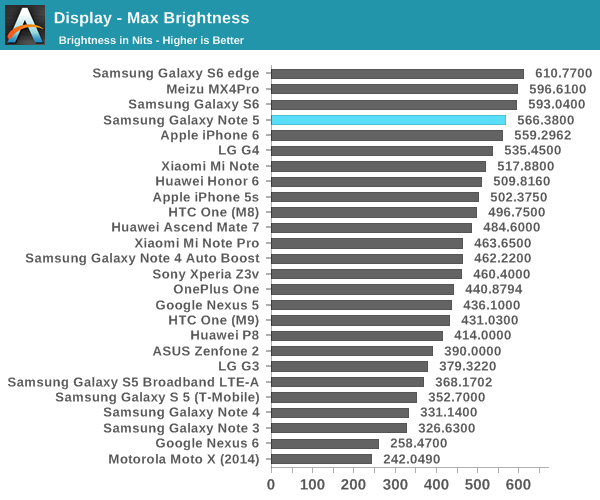
Moving on to our brightness testing, we can see that the Galaxy Note5 delivers a healthy improvement over the Galaxy Note 4 generation of AMOLED, but it isn’t quite at the same level as the Galaxy S6. It isn’t clear why this is the case, but I suspect this is related to longevity and other concerns outside of brightness. Meanwhile the use of OLED means that black levels are perfect and contrast remains solely determined by the lighting of the room and the reflectance of the display, which is similar to most other smartphones.
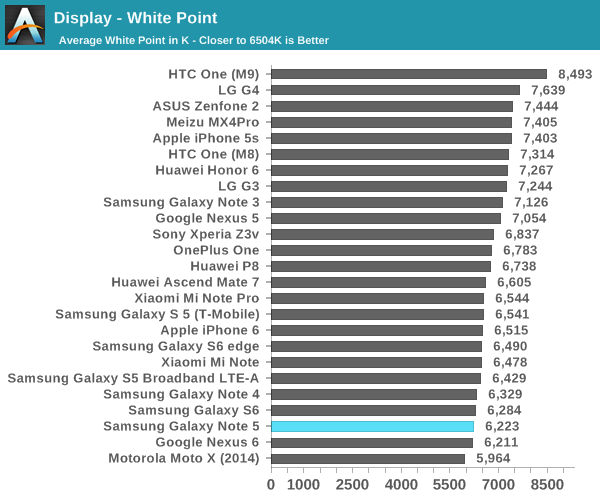
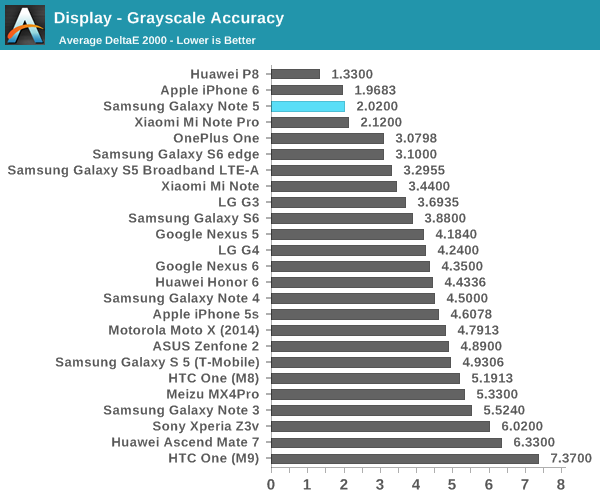
In our standard grayscale testing, the Note5 delivers acceptable color accuracy but it seems that the Basic screen mode tends towards a warm color balance. I suspect this helps with power efficiency, as blue in general requires more power to achieve the same level of luminance. Other than this slightly warm white balance, the grayscale accuracy doesn’t have any significant errors. This means accuracy ends up very good - certainly below our threshold for noticable errors - especially in comparison to the Galaxy Note 4 which had some noticeable problems with green tint on some units.
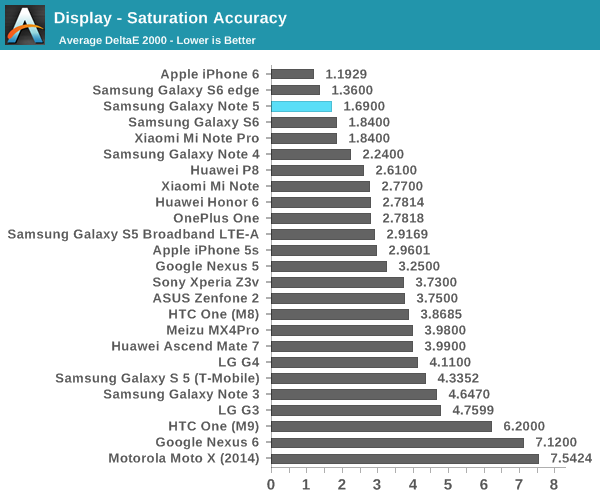
In our saturation test, Samsung does well enough that there’s really nothing to talk about because there's so little wrong here. You could argue that magenta is a bit warm on our review unit, but the difference is too small to be worth talking about. Error on average is going to be hard to spot unless you have a flawless reference monitor to compare against.
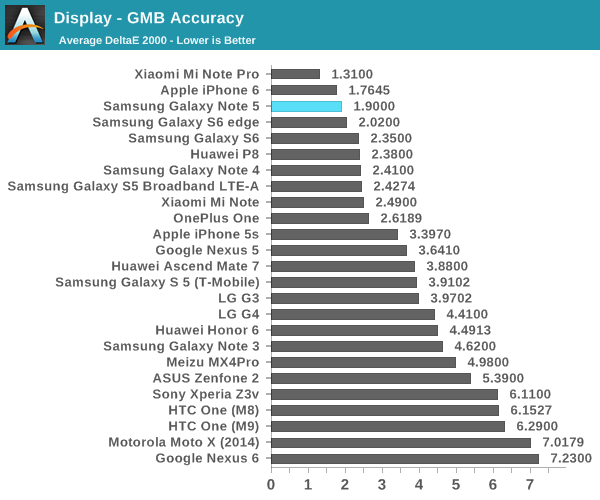
In the GMB ColorChecker test, Samsung continues to show a strong performance when looking at various hues that are commonly found in consumer content such as movies and camera photos. There’s a slight red shift on some of the tested hues, but the error is so minor I don’t notice that any problems here.
Overall, the Galaxy Note5 and Galaxy S6 edge+ both have an incredible display. The Galaxy S6 edge+ does have some problems with viewing angle shifts by virtue of the curved display, but this is effectively unavoidable given the subpixel layout and the radius of curvature. With this generation of AMOLED, Samsung has definitely equaled the best LCDs on the market. I suspect within the next year or two it will be inevitable that Samsung AMOLED will be clearly superior to even the best LCDs. However, without other OLED suppliers that can provide similar quality and cost I suspect OEM adoption will continue to be limited.



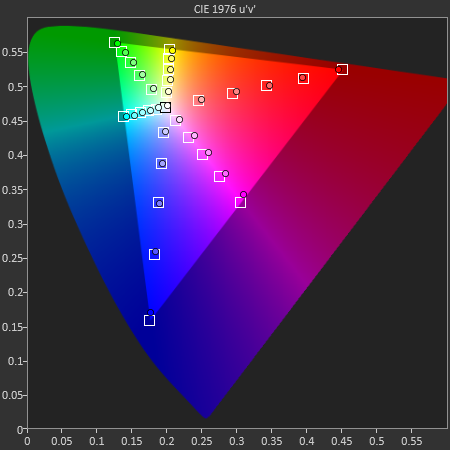
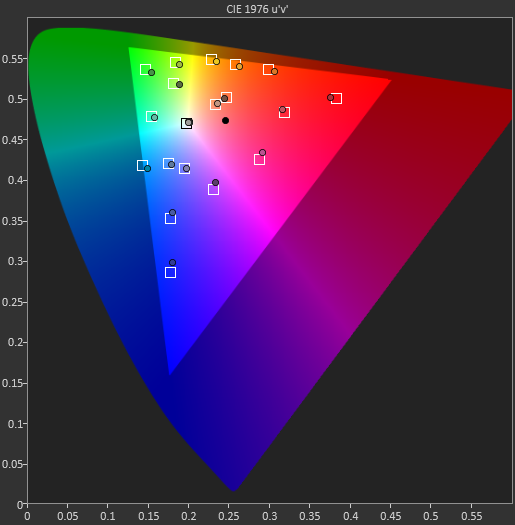








225 Comments
View All Comments
melgross - Saturday, October 3, 2015 - link
I'm not convinced that the 8/4 solution is a good one. Four weak cores, and four even weaker cores may look good in multiprocessing tests, but in the real world, it's going to lag.mercucu1111 - Friday, October 2, 2015 - link
Exynos 7420 Full load Geekbench : 5600A9 Full load Geekbench : 4400
So E7420 CPU is 30% higher.
According to GFX 3.0 and 2.7
A9 GPU is 40% higher.
So Nobody can say which is better lol
melgross - Saturday, October 3, 2015 - link
The multiprocessing tests mean little though. They're often questioned. The problem is that real world use doesn't function that way.darwinosx - Friday, October 2, 2015 - link
Heh. Kids. Apple sales have destroyed Samsung as is well known.Kuzi - Friday, October 2, 2015 - link
As of Q2 2015, Samsung has 21.4% of the Smarphone market, Apple has 13.9%:http://www.idc.com/prodserv/smartphone-market-shar...
Well known yeah right.
tipoo - Friday, October 2, 2015 - link
Is that 21% high end phones like the GS6, or all the cheap phones with razor margins they also have?hughlle - Friday, October 2, 2015 - link
Irrelevant to the statement darwinosx made.. he stated Apple sales have destroyed Samsung's sales. Clearly they havnt. The type of phones Mali g up the figures is irrelevant to that statement.lukarak - Friday, October 2, 2015 - link
Well, if you mention sales, you know, exchange of stuff for money, then money made is much much more important than unit numbers to judge someones performance. Because, they do sales to earn money, not to ship units. And Apple destroys Samsung in that regard.Kuzi - Friday, October 2, 2015 - link
Remember that since the first iPhone till now most of the SOCs used were made by Samsung. Also Samsung supplied RAM, screens, flash etc for the iPhones and iPads. The IPhone 6 SOC and RAM is supplied by samsung. So for every iPhone/IPad sold, Samsung makes money. It has been thisnway since the first IPhone, enjoy.Morawka - Friday, October 2, 2015 - link
yay apple makes more money, but samsung sells more phones.. hmm interesting. i would say android wins because they make it all up on app sales and profits